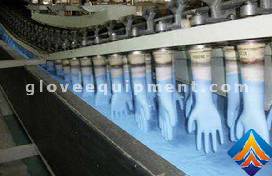Medical gloves are widely used, and are used in hospitals, laboratories, and dentistry. Properly wearing medical gloves is not only clean and hygienic, but also protects the health of medical personnel. The general medical gloves are divided into nitrile gloves and rubber gloves. What is the difference between these two gloves? How to wear medical gloves correctly? Nitrile Gloves equipment Suppliers will introduce you.
1. What are the differences between nitrile gloves and rubber gloves?
Nitrile gloves
Material: Nitrile rubber, nitrile gloves, synthetic rubber, the main components are acrylonitrile and butadiene
Advantages: Not allergic, easy to degrade, can add pigments, rich in color
Disadvantages: not as flexible as latex gloves
Latex gloves
Material: natural latex
Advantages: good elasticity and degradability
Disadvantages: allergic to a small number of people, can not add pigments, single color.
Industry recommended gloves
Hygiene: Cleaners need to wear gloves to protect themselves from chemicals in cleaning supplies and protect themselves from pathogens during cleaning. Nitrile gloves are resistant to harmful chemicals, so health workers use nitrile gloves as the best option.
Maintenance personnel: Maintenance personnel will be exposed to grease, oil and other solvents when repairing equipment and vehicles used in production. At this time, their hands need to be protected. Nitrile gloves can well isolate these harmful substances.
Printing workers: Printing houses use chemicals to print labels and other printed materials. These chemicals usually contain emulsions, inks, oxidants and various solvents. Disposable gloves prevent chemicals from damaging workers' health, such as penetrating the skin and causing injury.
Food industry: Nitrile gloves are comfortable to wear, suitable for long-term wear, and have a variety of color options. They are ideal for food processing and food service industries.
Hairdressing industry: Nitrile gloves are comfortable and suitable for long-term wear. They are also ideal for the hairdressing industry. They can avoid chemical irritation and damage to the skin. It can be used in many industries like this. Disposable nitrile gloves are suitable for many industries and are ideal for you.
Medical industry: Nitrile gloves and latex gloves have an indispensable position in the medical industry. Although the two gloves have the meaning of competition, there are times when they complement each other.

Nitrile Gloves Equipment
Second, the correct way to wear medical gloves
1. Put on a pair of talcum powder (or medical starch) with your hands in dry gloves, so that you can wear gloves. Hold the inner surface of the reflexed part of the glove with your right hand. Take out a pair of dry gloves. , Put the left hand into the outer circle of the right hand reflex, and then the right hand into the glove (you can also wear the right glove first); pull the reflex of the glove over the cuff without exposing your wrist; before wearing the glove Do not touch the outside of the glove. After wearing the glove, do not touch the skin. Afterwards, rinse the talc powder on the glove with sterile saline before operating.
2. After disinfecting with wet gloves, wear gloves while wet, take a pair of wet gloves from the glove basin, hold water in the glove, and after the left hand reaches into the glove, raise the left hand slightly to let the water flow out of the wrist Wear it, then put your left hand into the outer fold and wear the right glove. Raise your right hand to let the water flow out of the wrist (you can also wear the right glove first). Put on the surgical gown and put the glove back to the cuff No wrists should be exposed, and conditional hospitals should generally not use this method.
3. Wear double-layer gloves Double-layer gloves can reduce the wearer's exposure to danger. If you need to wear double-layer gloves (such as chemotherapy, bone marrow aspiration) in certain operations, you need loose gloves so that you can put one Put it on the other one.
4. Change the gloves. After contacting the suspected contaminated area or object of the same patient, the gloves should be changed before touching the mucosa. Before touching non-contaminants or needing to dispose of other patients, you should take off your gloves and wash your hands or disinfectant immediately to avoid spreading microorganisms to other patients or objects.
5. Glove wearing time The longer the glove is worn, the more easily the protective barrier is damaged. The use of gloves under harsh conditions or contact with various chemicals may cause fatigue of the gloves. Therefore, the gloves should be replaced appropriately during operation. During the operation, if the gloves are damaged or suspected of being contaminated, they should be replaced immediately.
6. In the process of taking off the gloves, the source of infection will contaminate the outer surface of the gloves. It is important to take off the gloves correctly. The gloves cannot be forcibly pulled when taking off the gloves. The gloves should be flipped off gently and the hands should not touch the outside of the gloves. The removed gloves should be disinfected in time, and should not be thrown into the waste bin. Taking off the gloves incorrectly may lead to the spread of contaminants outside the gloves. At this time, even the best barrier function is meaningless.
Our company sells Nitrile Gloves Equipment, if you are interested in our products, please feel free to contact us.